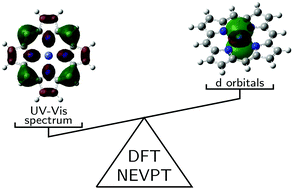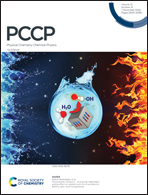Can one use the electronic absorption spectra of metalloporphyrins to benchmark electronic structure methods? A case study on the cobalt porphyrin†
Abstract
In this article, we describe calculations on the absorption spectrum of cobalt(II) porphyrin, using density functional (DFT) and multireference n-electron valence perturbation (NEVPT) theories. With these calculations, we describe the lowest-energy states of doublet and quartet spin multiplicities, the excited states that originate the Q and B bands of porphyrins, some higher-energy π–π* excitations and charge-transfer states, HOMO–LUMO gaps, and ionisation potentials. Results undoubtedly show that the position of B band is essentially independent on the DFT functional, while the Q band is better described by pure functionals, and these bands do not depend on the initial state of the transition (whether doublet or quartet) as well. However, other excitation energies, orbital energies, and ionisation potentials strongly depend on the functional, in some cases varying more than 2 eV. Based on these results we conclude that one should not use the UV-Vis spectrum of metalloporphyrins to benchmark density functionals, mainly those properties related to coordination with the metallic ion. Furthermore, the results show that functionals that yield correct spectra may be based on an incorrect ground state description. Moreover, we reinforce that one must be skeptical about the reference chosen to benchmark electronic structure calculations, such as DFT functionals and active spaces for multireference calculations.

- This article is part of the themed collection: Quantum Theory: The Challenge of Transition Metal Complexes


 Please wait while we load your content...
Please wait while we load your content...